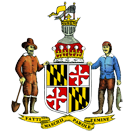| Culpepper (later Fairfax) grant to the Northern neck of Virginia, September 27, 1688. In The Virginia Magazine of History and Biography, XV:392-99. [This grant contained language that asserted ownership of the whole of the Potomac River. It did not revoke prior grants, including the earlier grant to Lord Baltimore of June 1632 that also included the whole of the Potomac River. Defining the extent of the grant was a long process concluded by a decision by the Privy Council on April 11, 1745, in favor of Fairfax's claim as to the source of the Potowmac. That decision resulted in the map referred to by Cecilius Calvert (see detail from the ca. 1747 map). See Charles M. Andrews, The Colonial Period of American History. New Haven: Yale University Press, 1936. Vol. II:234-238, for a discussion of the Fairfax grant. See also the minutes of the Privy Council relating to the mapping of Fairfax's boundaries. It is important to stress that the Privy Council explicitly did not address anything other than the location of the line from the headwaters of the Rappahanock to the headwaters of the Potomac. It did not address the meaning or application of any other language in the charter:
1745 6 April. [Committee: 14 present. The committee rehearse the case, and recommend that] the question being only concerning that Boundary which ought to be drawn from the first head or spring of the River Rappahannock to the first head or Spring of the River Pattawomeck alias Potowmack the committee do Agree humbly to Report to Your Majesty as their Opinion that within the words and meaning of the Letters Patent Granted by King James the second bearing date the 27th day of September in the fourth Year of his Reign the said Boundary ought to begin at the first Spring of the ... Rappahannock now called Rappidan ...in a Streight Line North West to ... where the River Patawomeck alias Potowmack ...first Arises the other Boundarys being the said Rivers themselves as they run from their said respective Heads till they fall into Chesapeyock alias Chesapeak Bay...]
According to Whealton, p. 20, "Charles, [5th] Lord Baltimore, was not represented and had no part in the work" of the Commission that mapped Fairfax's claim." The commission to map the area was the result of a 1733 petition to the king for a survey to have the bounds of the Fairfax grant determined. For much of 1733, Charles was in Maryland and may not have been aware of the petition that resulted in the commission, but as Cecil Calvert makes clear, Charles did know of the proceedings in 1745 and of the resulting map. That was the whole point of Cecilius's letter to Sharpe (MSA SC 5796-10-16). He was expressing shock and amazement that Charles did not join, nor contest the survey. According to Cecilius (Charles's brother) Charles was present at the 1745 Privy Council hearings held because Virginia and Fairfax could not agree on the location of Fairfax's boundary. Those hearings only dealt with the location of the fountainhead of the Potomac. They did not address the assertion in the language of the Fairfax grant that Fairfax owned the whole of the river Potomac. That assertion would be left to the Supreme Court to carefully review and reject many years later. As Justice Shiras decreed in Morris v. U.S. ( 174 U.S. 196):
we agree with the conclusion of the court below, that, upon all the evidence, the charter granted to Lord Baltimore, by Charles I, in 1632, of the territory known as the Province of Maryland, embraced the Potomac River and the soil under it, and the islands therein, to high-water mark on the southern or Virginia shore; that the territory and title thus [***49] granted to Lord Baltimore, his heirs and assigns, were never divested by any valid proceedings prior to the Revolution; nor was such grant affected by the subsequent grant to
Lord Culpeper.
The record discloses no evidence that, at any time, any substantial claim was ever made by Lord Fairfax, heir at law of Lord Culpeper, or by his grantees, to property rights in the Potomac River or in the soil thereunder, nor does it appear that Virginia ever exercised the power to grant ownership in the islands or soil under the river to private persons. Her claim seems to have been that of political jurisdiction.
Without pursuing further this branch of the subject, and assuming that the heirs of John [**662] Marshall have become lawfully vested with the Fairfax title, we are of opinion that they have failed to show any right or title to the lands and promises involved in this litigation, and that the decree of the court below, so far as it affects them, is free from error.
|
